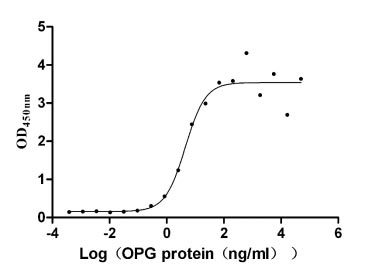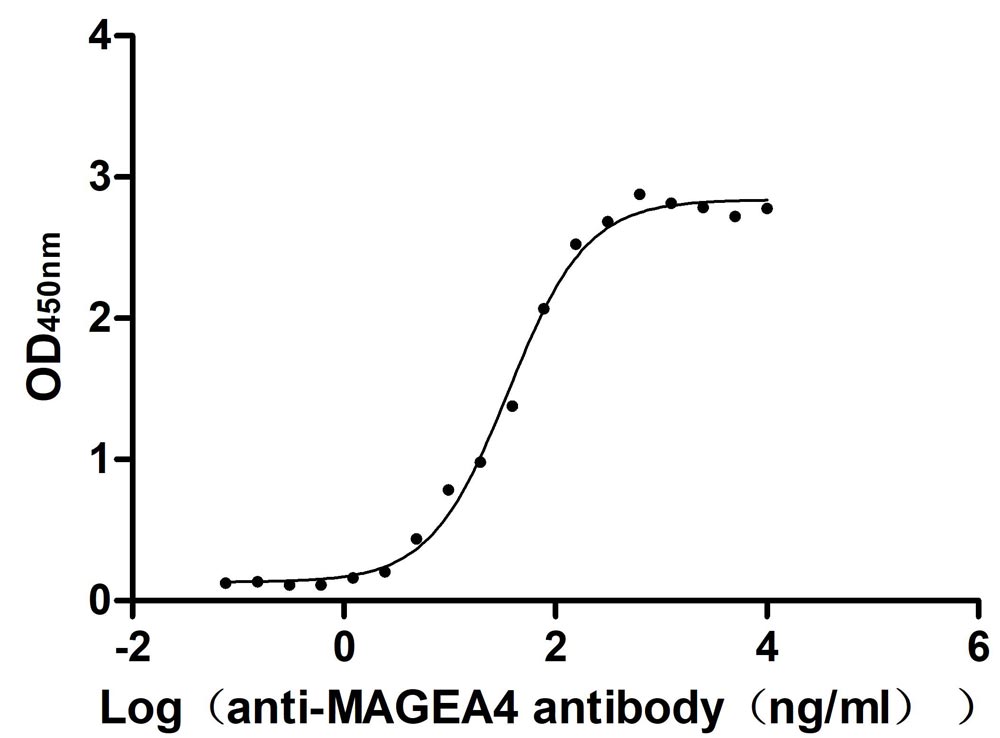Recombinant Human Melanoma antigen preferentially expressed in tumors (PRAME)
In Stock-
货号:CSB-EP018603HU
-
规格:¥1344
-
图片:
-
其他:
产品详情
-
纯度:Greater than 90% as determined by SDS-PAGE.
-
基因名:PRAME
-
Uniprot No.:
-
别名:4930534P07Rik; Cancer/testis antigen 130; CT130; MAPE; Melanoma antigen preferentially expressed in tumors; OIP 4; OIP-4; OIP4 ; OPA interacting protein 4; Opa interacting protein OIP4; OPA-interacting protein 4; PRAME; PRAME_HUMAN; Preferentially expressed antigen in melanoma ; Preferentially expressed antigen of melanoma; RP23-250F8.3
-
种属:Homo sapiens (Human)
-
蛋白长度:Full Length
-
来源:E.coli
-
分子量:61.9kDa
-
表达区域:1-509aa
-
氨基酸序列MERRRLWGSIQSRYISMSVWTSPRRLVELAGQSLLKDEALAIAALELLPRELFPPLFMAAFDGRHSQTLKAMVQAWPFTCLPLGVLMKGQHLHLETFKAVLDGLDVLLAQEVRPRRWKLQVLDLRKNSHQDFWTVWSGNRASLYSFPEPEAAQPMTKKRKVDGLSTEAEQPFIPVEVLVDLFLKEGACDELFSYLIEKVKRKKNVLRLCCKKLKIFAMPMQDIKMILKMVQLDSIEDLEVTCTWKLPTLAKFSPYLGQMINLRRLLLSHIHASSYISPEKEEQYIAQFTSQFLSLQCLQALYVDSLFFLRGRLDQLLRHVMNPLETLSITNCRLSEGDVMHLSQSPSVSQLSVLSLSGVMLTDVSPEPLQALLERASATLQDLVFDECGITDDQLLALLPSLSHCSQLTTLSFYGNSISISALQSLLQHLIGLSNLTHVLYPVPLESYEDIHGTLHLERLAYLHARLRELLCELGRPSMVWLSANPCPHCGDRTFYDPEPILCPCFMPN
Note: The complete sequence including tag sequence, target protein sequence and linker sequence could be provided upon request. -
蛋白标签:N-terminal 6xHis-tagged
-
产品提供形式:Liquid or Lyophilized powder
Note: We will preferentially ship the format that we have in stock, however, if you have any special requirement for the format, please remark your requirement when placing the order, we will prepare according to your demand. -
缓冲液:Tris-based buffer,50% glycerol
-
储存条件:Store at -20°C/-80°C upon receipt, aliquoting is necessary for mutiple use. Avoid repeated freeze-thaw cycles.
-
保质期:The shelf life is related to many factors, storage state, buffer ingredients, storage temperature and the stability of the protein itself.
Generally, the shelf life of liquid form is 6 months at -20°C/-80°C. The shelf life of lyophilized form is 12 months at -20°C/-80°C. -
货期:3-7 business days
-
注意事项:Repeated freezing and thawing is not recommended. Store working aliquots at 4°C for up to one week.
-
产品描述:
CUSABIO transfected the expression vector which inserted the recombinant DNA into the E.coli, cultured the cells, and then induced the transcription and translation of the cloned vector. The N-terminal 6xHis tag sequence was appended to the gene coding for the E.coli of the human PRAME protein to form the recombinant DNA. The recombinant human PRAME was expressed as N-terminal 6xHis-tagged fusion. The purity of the protein is greater than 90% assayed by SDS-PAGE. It has an apparent molecular weight of approximately 55 kDa.
PRAME is a tumor-associated antigen, which belongs to the family of cancer–testis antigens. Gene PRAME was found to encode an antigen recognized on a human melanoma cell line by an autologous cytolytic T-lymphocyte clone. This gene is expressed at a high level in a very large fraction of tumours, such as melanomas, non-small-cell lung carcinomas, sarcomas, head and neck tumours and renal carcinomas. It is therefore a candidate for tumour immunotherapy even though some low expression is found in certain normal tissues. Although diffuse immunoreactivity for PRAME is found in most primary cutaneous melanomas, melanocytic nevi express PRAME usually only in a subpopulation of tumor cells. In addition, studies have shown that unlike the MAGE, GAGE and BAGE genes, PRAME was expressed at a significant level in peripheral blood or bone marrow samples from patients with a malignant blood disease.
-
Datasheet & COA:Please contact us to get it.
相关产品
靶点详情
-
功能:Substrate-recognition component of a Cul2-RING (CRL2) E3 ubiquitin-protein ligase complex, which mediates ubiquitination of target proteins, leading to their degradation. The CRL2(PRAME) complex mediates ubiquitination and degradation of truncated MSRB1/SEPX1 selenoproteins produced by failed UGA/Sec decoding. In the nucleus, the CRL2(PRAME) complex is recruited to epigenetically and transcriptionally active promoter regions bound by nuclear transcription factor Y (NFY) and probably plays a role in chromstin regulation. Functions as a transcriptional repressor, inhibiting the signaling of retinoic acid through the retinoic acid receptors RARA, RARB and RARG: prevents retinoic acid-induced cell proliferation arrest, differentiation and apoptosis.
-
基因功能参考文献:
- Knockdown PRAME in HCC cells, increased cell apoptosis was correlated with the proportion of cells in G0/G1 stage, activated p53 mediated apoptosis, and increased cyclin p21 expression. PMID: 29439259
- PRAME is frequently expressed in epithelial ovarian cancer at the mRNA and protein levels, and DNA methylation is a key mechanism regulating its expression. PMID: 27322684
- PRAME is aberrantly hypomethylated and activated in Class 1 and Class 2 uveal melanomas and is associated with increased metastatic risk in both classes PMID: 27486988
- To investigate the impact of gene copy number variation on PRAME expression, plasma cells were sorted from 50 newly diagnosed multiple myeloma patients and 8 healthy volunteers to measure PRAME transcript levels and gene copy numbers by real-time quantitative polymerase chain reaction. PMID: 28953414
- Tumor antigen PRAME is up-regulated by MZF1 in cooperation with DNA hypomethylation in melanoma cells. PMID: 28634046
- Results support the potential utility of NY-ESO-1, PRAME, and MAGEA4 as targets for immunotherapy and as ancillary prognostic parameters in synovial sarcomas. PMID: 27993576
- PRAME plays a role in preventing the invasion and metastasis of lung adenocarcinoma PMID: 27391090
- PRAME is expressed in many primary and metastatic UMs, and about half of the metastatic UMs coexpress PRAME and HLA class I. PMID: 28448663
- PRAME is a downstream factor of SOX17 and LIN28 in regulating pluripotency and suppressing somatic/germ cell differentiation in primordial germ cells, germ cell neoplasia in situ, and seminomas. PMID: 27441500
- In line with its roles in controlling cell growth, RPAME regulates multiple critical cell-growth related genes, including IGF1R oncogene. IGF1R up-regulation contributes to increase of cell growth upon the knockdown of PRAME. PMID: 27241212
- This study demonstrates that PRAME functions as a tumor suppressor in breast cancer. PMID: 27632898
- PRAME is an independent prognostic biomarker in Uveal melanoma , which identifies increased metastatic risk in patients with Class 1 or disomy 3 tumors. PMID: 26933176
- Leukemias expressing high levels of PRAME had higher levels of cell death by regulating S100A4/p53 signaling. PMID: 27049257
- Our results suggest that the leukemias expressing high levels of PRAME has favorable prognosis PMID: 26823776
- PRAME expression is considered as a poor prognostic parameter in HL. PMID: 26044287
- PRAME immunoreactivity in myeloid leukemia (ML) of Down syndrome (DS) is largely due to the non-blast components, while PRAME immunoreactivity in blasts of Transient abnormal myelopoiesis (TAM) is not restricted to cases that progress to ML of DS. PMID: 25887863
- This study shows the prognostic significance of PRAME expression in diffuse large B-cell lymphoma patients treated with R-CHOP therapy. PMID: 24820636
- results suggested that PRAME was a predictor for better outcome, could be a useful target for immunotherapy, and might represent a candidate marker for the monitoring of minimal residual disease PMID: 24600975
- elevated PRAME expression in head and neck squamous cell carcinoma PMID: 23905893
- PRAME and WT1 transcripts constitute a good molecular marker combination for monitoring minimal residual disease in MDS. PMID: 23110703
- PRAME impairs differentiation and increases proliferation likely via blocking retinoic acid receptor signaling. PMID: 23444226
- PRAME is upregulated by signalling pathways that are activated in response to infection/inflammation. PMID: 23460923
- The complex PRAME/EZH2 is able to repress TRAIL expression, in a cancer-specific manner; inhibition of PRAME/EZH2 releases apoptosis-mediating TRAIL. (Review) PMID: 23228130
- PRAME and its paralogs are leucine rich repeat proteins. Structure predictions suggest PRAME resembles the extracellular domains of TLR3 and TLR4, or intracellular NALP family. This suggests PRAME may have a role in sensing Pathogen Associated Molecular Patterns (PAMPs). PMID: 23460923
- PRAME expression in leukaemic cell lines is upregulated by IFN gamma and LPS, suggesting a possible role in immune responses. PRAME associates with Elongin BC complexes by binding Elongin C, and co-localises to the Golgi network. Nuclear PRAME interacts with Histone H3. The results suggest that PRAME has dual roles in gene regulation in the nucleus and protein turnover trafficking in the Golgi PMID: 23460923
- Knock-down of PRAME increases retinoic acid signaling and cytotoxic drug sensitivity of Hodgkin lymphoma cells. PMID: 23409080
- a novel link between the oncoprotein PRAME and the conserved EKC complex PMID: 22912744
- PRAME as biomarkers for solid tumor PMID: 23075240
- NYESO-1/LAGE-1s and PRAME are targets for antigen specific T cells in chondrosarcoma following treatment with 5-Aza-2-deoxycitabine PMID: 22384167
- PRAME expression is regulated at the epigenetic level. For this reason inhibitors of DNA methylation, such as 5-azacytidine, can modulate the expression of this tumor associated antigen. PMID: 22503131
- Studies suggest that activated human gammadelta T cells can efficiently present PRAME and STEAP1-derived epitopes and allow breaking tolerance against these tumor-associated self-antigens. PMID: 21928126
- these results suggest that PRAME plays an important role in cell proliferation and disease progression in osteosarcoma. PMID: 22390931
- the expansion of the PRAME family occurred in both autosomes and sex chromosomes PMID: 21347312
- PRAME effectively differentiates mullerian carcinoma from malignant mesothelioma at the mRNA and protein levels. PMID: 22261449
- PRAME expression might be related to distinct patterns of tumorigenesis PMID: 21691740
- PRAME plays an important role in disease progression in acute leukemia. PMID: 21550659
- The s applied protein-complex purification strategies and identified PRAME as a substrate recognition subunit of a Cullin2-based E3 ubiquitin ligase. PMID: 21822215
- The level of prame gene transcript increases in chronic myeloid leukemia which associates with disease progression. PMID: 20723287
- The cytotoxic activity of our PRAME-specific CTLs was directed not only against leukemic blasts, but also against leukemic progenitor cells as assessed by colony-forming-inhibition assays, which have been implicated in leukemia relapse. PMID: 21278353
- PRAME may be involved in the tumorigenic process in a wide range of cancers, at least in part by blocking the tumor suppressor pathway mediated by TRAIL expression. PMID: 20838376
- Results showed the expression of MCSP and PRAME in conjunctival melanoma and benign conjunctival nevi and showed that MCSP and PRAME were differentially expressed in both and can help to differentiate the lesions diagnostically. PMID: 20805128
- The PRAME transcript was highly expressed in acute myeloid leukemia patients and was a favorable marker of prognosis. PMID: 20376794
- PRAME mRNA could be used to monitor minimal residual disease in newly diagnosed acute myeloid leukemia patients. PMID: 19035174
- E2F4, PHACTR3, PRAME family member and CDH12 most probably play important role in non-small-cell lung cancer geneses PMID: 19473719
- expression of PRAME is an indicator of favorable prognosis and could be a useful tool for monitoring minimal residual disease in childhood AML. PMID: 11943337
- PRAME gene expression in childhood acute lymphoblastic leukemia PMID: 12419593
- PRAME is highly expressed in primary advanced neuroblastoma PMID: 15240516
- The overexpression of PRAME protein frequently observed in human cancers confers growth or survival advantages by antagonizing retinoic acid receptor(RAR) signaling. PMID: 16179254
- The results suggest that the analysis of PRAME protein may contribute for the distinction between normal and leukemic cells in chronic lymphoproliferative disorders(CLD), and that PRAME may be a potential target for therapy. PMID: 16620968
- PRAME is expressed in acute myeloblastic leukaemia PMID: 16681423
显示更多
收起更多
-
亚细胞定位:Nucleus. Chromosome. Cytoplasm. Golgi apparatus. Cell membrane.
-
蛋白家族:PRAME family
-
组织特异性:Expressed in testis. Detected in samples of kidney, brain and skin.
-
数据库链接:
HGNC: 9336
OMIM: 606021
KEGG: hsa:23532
STRING: 9606.ENSP00000381726
UniGene: Hs.30743
Most popular with customers
-
Recombinant Human Tumor necrosis factor receptor superfamily member 11B (TNFRSF11B) (Active)
Express system: Mammalian cell
Species: Homo sapiens (Human)
-
Recombinant Mouse Prolactin receptor (Prlr), partial (Active)
Express system: Mammalian cell
Species: Mus musculus (Mouse)
-
Recombinant Human Melanoma-associated antigen 4 (MAGEA4) (Active)
Express system: Mammalian cell
Species: Homo sapiens (Human)
-
Recombinant Human Angiopoietin-2 (ANGPT2) (Active)
Express system: Mammalian cell
Species: Homo sapiens (Human)
-
Recombinant Macaca mulatta Semaphorin-4D isoform 1 (SEMA4D), partial (Active)
Express system: Mammalian cell
Species: Macaca mulatta (Rhesus macaque)
-
Recombinant Human Cannabinoid receptor 1 (CNR1)-VLPs (Active)
Express system: Mammalian cell
Species: Homo sapiens (Human)
-
Recombinant Human Zymogen granule protein 16 homolog B (ZG16B) (Active)
Express system: Mammalian cell
Species: Homo sapiens (Human)
-
Recombinant Macaca fascicularis lymphocyte antigen 6 family member G6D (LY6G6D) (Active)
Express system: Yeast
Species: Macaca fascicularis (Crab-eating macaque) (Cynomolgus monkey)






-AC1.jpg)














